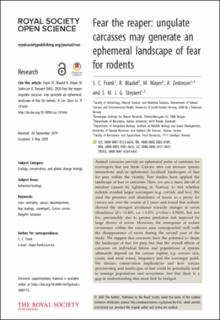| dc.contributor.author | Frank, Shane | |
| dc.contributor.author | Blaalid, Rakel | |
| dc.contributor.author | Mayer, Martin | |
| dc.contributor.author | Zedrosser, Andreas | |
| dc.contributor.author | Steyaert, Sam | |
| dc.date.accessioned | 2021-02-09T14:20:08Z | |
| dc.date.available | 2021-02-09T14:20:08Z | |
| dc.date.created | 2020-10-30T11:09:23Z | |
| dc.date.issued | 2020 | |
| dc.identifier.citation | Frank, S. C., Blaalid, R., Mayer, M., Zedrosser, A. & Steyaert, S. M. J. G. (2020). Fear the reaper: ungulate carcasses may generate an ephemeral landscape of fear for rodents: Rodents fear scavengers at mass die-off. Royal Society Open Science, 7(6). doi: | en_US |
| dc.identifier.issn | 2054-5703 | |
| dc.identifier.uri | https://hdl.handle.net/11250/2726963 | |
| dc.description.abstract | Animal carcasses provide an ephemeral pulse of nutrients for scavengers that use them. Carcass sites can increase species interactions and/or ephemeral, localized landscapes of fear for prey within the vicinity. Few studies have applied the landscape of fear to carcasses. Here, we use a mass die-off of reindeer caused by lightning in Norway to test whether rodents avoided larger scavengers (e.g. corvids and fox). We used the presence and abundance of faeces as a proxy for carcass use over the course of 2 years and found that rodents showed the strongest avoidance towards changes in raven abundance (β = −0.469, s.e. = 0.231, p-value = 0.0429), but not fox, presumably due to greater predation risk imposed by large droves of raven. Moreover, the emergence of rodent occurrence within the carcass area corresponded well with the disappearance of raven during the second year of the study. We suggest that carcasses have the potential to shape the landscape of fear for prey, but that the overall effects of carcasses on individual fitness and populations of species ultimately depend on the carcass regime, e.g. carcass size, count, and areal extent, frequency and the scavenger guild. We discuss conservation implications and how carcass provisioning and landscapes of fear could be potentially used to manage populations and ecosystems, but that there is a gap in understanding that must first be bridged. | en_US |
| dc.language.iso | eng | en_US |
| dc.publisher | The Royal Society Publishing | en_US |
| dc.rights | Navngivelse 4.0 Internasjonal | * |
| dc.rights.uri | http://creativecommons.org/licenses/by/4.0/deed.no | * |
| dc.title | Fear the reaper : ungulate carcasses may generate an ephemeral landscape of fear for rodents : Rodents fear scavengers at mass die-off | en_US |
| dc.type | Peer reviewed | en_US |
| dc.type | Journal article | en_US |
| dc.description.version | publishedVersion | en_US |
| dc.rights.holder | © 2020 The Author(s) | en_US |
| dc.subject.nsi | VDP::Matematikk og Naturvitenskap: 400 | en_US |
| dc.subject.nsi | VDP::Matematikk og Naturvitenskap: 400::Zoologiske og botaniske fag: 480::Økologi: 488 | en_US |
| dc.source.pagenumber | 11 | en_US |
| dc.source.volume | 7 | en_US |
| dc.source.journal | Royal Society Open Science | en_US |
| dc.source.issue | 6 | en_US |
| dc.identifier.doi | 10.1098/rsos.191644 | |
| dc.identifier.cristin | 1843556 | |
| dc.relation.project | Andre: National Geographic Society | en_US |

